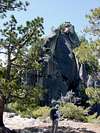Approach
Though the easiest route to the peak, the approach involves the most work. Distance-wise, the LeConte Gully is the shortest way, a mere half-mile up from Happy Isle. For most parties, it is not the quickest approach due to considerably more technical difficulties (class 4). The easiest approach follows the John Muir Trail up past Nevada Falls and utilizes the approach to Half Dome's
Snake Dike. After reaching Lost Lake and heading west to the shallow saddle between Mt. Broderick and Half Dome, you have several choices. You can either follow the rest of the approach to Snake Dike and then climb down the SW Shoulder of Half Dome towards Grizzly Peak (this involves about an extra 500ft of elevation gain), or you can head more or less directly for Grizzly, breaching the cliffs on the south side of Half Dome's SW Shoulder where trees and shrubs show a break in the cliffs. This second option may involve moderate to heavy bushwhacking depending on route-finding skills.
Route Description
The route from the notch is not terribly difficult, no more than about 30 minutes of scrambling. The short NE Arete rises from the notch to Grizzly's summit - stay on the left (east) side of this arete, circling around in a clockwise fashion to the west side of the peak once you are about 50 feet below the summit itself. You can climb through a rock tunnel on the west side or traverse around on a thin, but exposed ledge to the summit blocks.
Essential Gear
No special gear needed. Long pants and gloves may be helpful for potential bushwhacking on the approach.
Miscellaneous Info
If you have information about this route that doesn't pertain to any of the other sections, please add it here.




